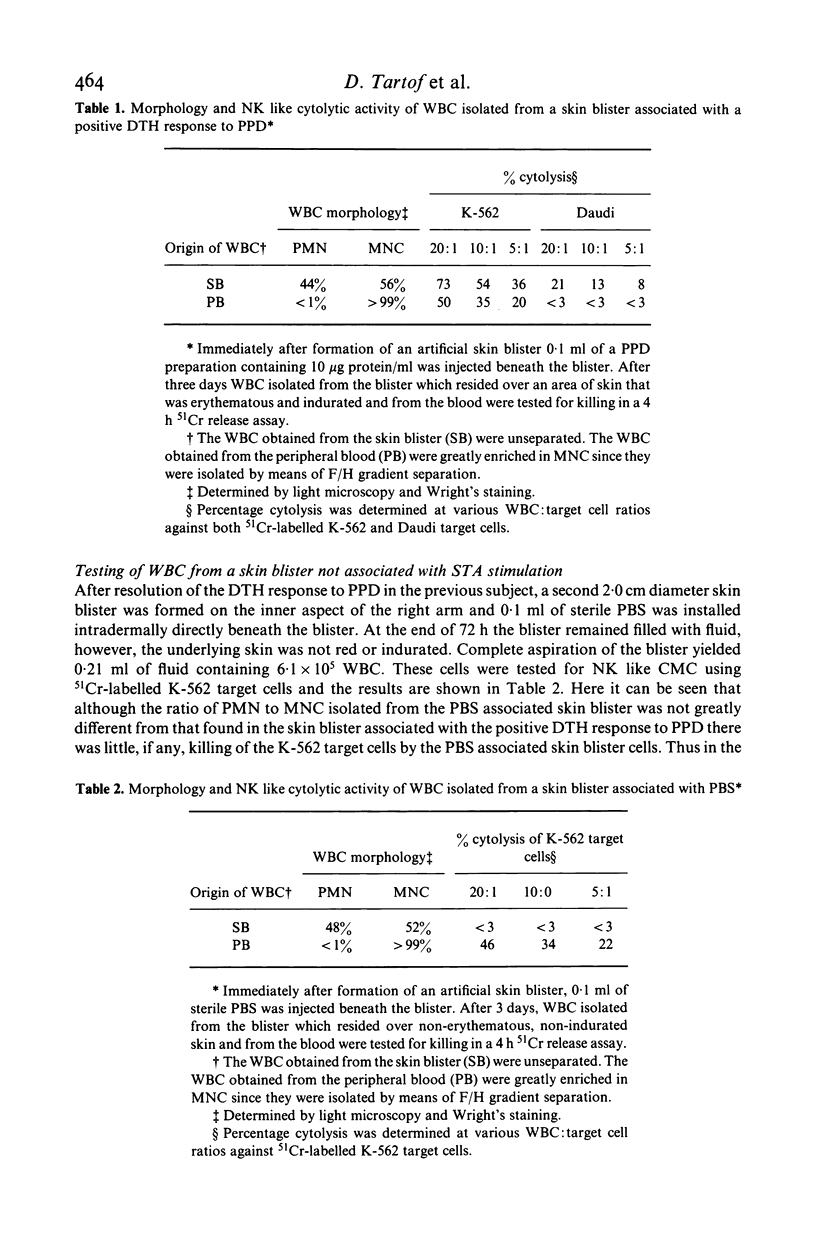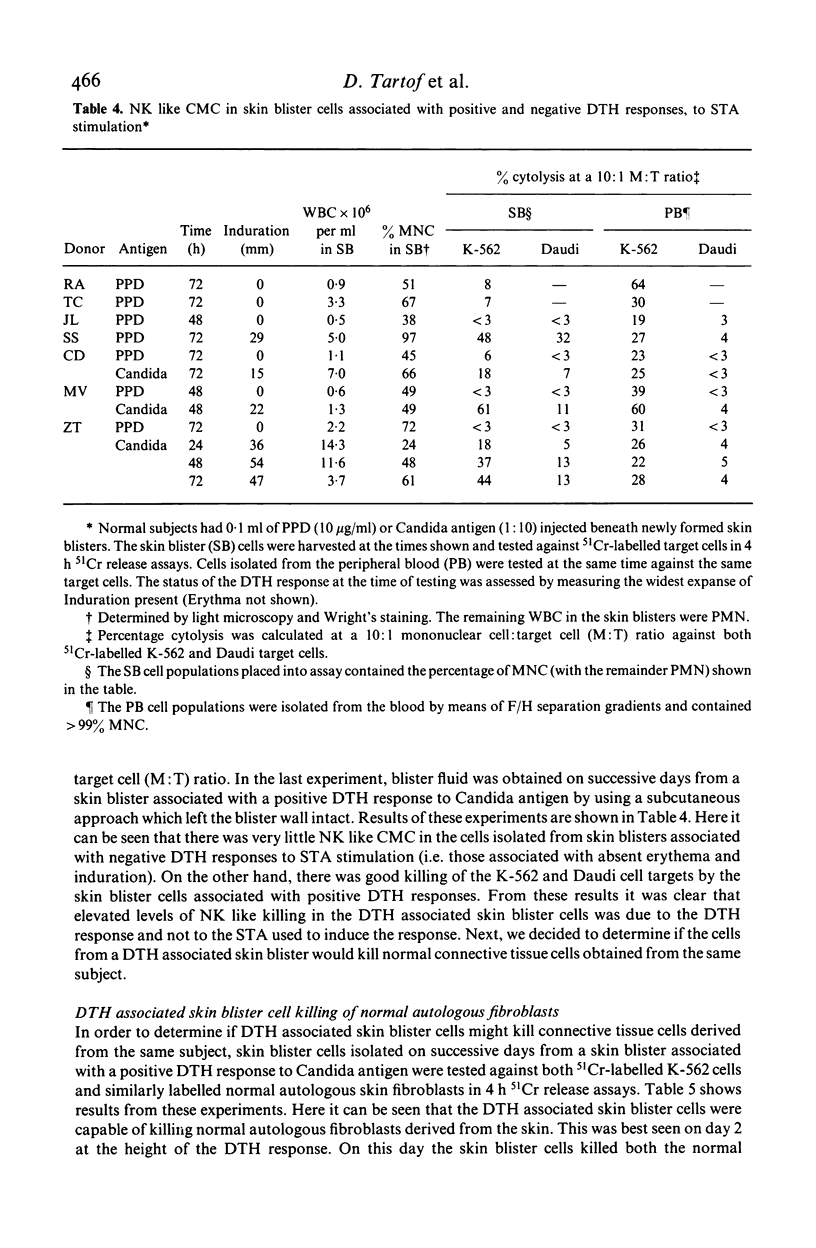Abstract
By inducing delayed type hypersensitivity (DTH) responses under previously formed skin blisters we determined that cells which mediate natural killer (NK) like cytotoxicity are present in the DTH response in man. Similar levels of killing were not present in cells obtained from skin blisters not associated with positive DTH responses. The DTH response associated killer cell was found to be a mononuclear cell that had presumably undergone stimulation since it not only killed NK sensitive K-562 cells, but also NK resistant Daudi target cells.
Full text
PDF







Selected References
These references are in PubMed. This may not be the complete list of references from this article.
- Andrianakos A. A., Tsichlis P. N., Merikas E. G., Marketos S. G., Sharp J. T., Merikas G. E. Cell-mediated immunity in systemic lupus erythematosus. Clin Exp Immunol. 1977 Oct;30(1):89–96. [PMC free article] [PubMed] [Google Scholar]
- Masucci M. G., Klein E., Argov S. Disappearance of the NK effect after explantation of lymphocytes and generation of similar nonspecific cytotoxicity correlated to the level of blastogenesis in activated cultures. J Immunol. 1980 May;124(5):2458–2463. [PubMed] [Google Scholar]
- Ojo E., Haller O., Wigzell H. Corynebacterium parvum-induced peritoneal exudate cells with rapid cytolytic activity against tumour cells are non-phagocytic cells with characteristics of natural killer cells. Scand J Immunol. 1978;8(3):215–222. doi: 10.1111/j.1365-3083.1978.tb00513.x. [DOI] [PubMed] [Google Scholar]
- Rosenthal C. J., Franklin E. C. Depression of cellular-mediated immunity in systemic lupus erythematosus. relation to disease activity. Arthritis Rheum. 1975 May-Jun;18(3):207–217. doi: 10.1002/art.1780180303. [DOI] [PubMed] [Google Scholar]
- Seeley J. K., Golub S. H. Studies on cytotoxicity generated in human mixed lymphocyte cultures. I. Time course and target spectrum of several distinct concomitant cytotoxic activities. J Immunol. 1978 Apr;120(4):1415–1422. [PubMed] [Google Scholar]
- Tartof D., Check I. J., Matutis A., Hunter R. L., Fitch F. W. Studies on stimulation of cell-mediated cytotoxicity by skin test antigens. I. Candida antigen stimulation of cell-mediated cytotoxicity in vitro correlated with the skin test response to candida antigen in vivo. J Immunol. 1980 Dec;125(6):2790–2796. [PubMed] [Google Scholar]
- Tartof D., Check I. J., Medof M. E. Stimulation of NK-like CMC by skin test antigens in vitro is depressed in patients with SLE. Clin Exp Immunol. 1982 Nov;50(2):253–258. [PMC free article] [PubMed] [Google Scholar]
- Tartof D., Curran J. J., Levitt D., Loken M. R. The skin test antigen stimulated killer (STAK) cell mediating NK like CMC is OKM1 positive and OKT3 negative. Clin Exp Immunol. 1983 Nov;54(2):561–566. [PMC free article] [PubMed] [Google Scholar]
- Tartof D., Curran J. J., Yang S. L., Livingston C. NK cell activity and skin test antigen stimulation of NK like CMC in vitro are decreased to different degrees in pregnancy and sarcoidosis. Clin Exp Immunol. 1984 Aug;57(2):502–510. [PMC free article] [PubMed] [Google Scholar]
- Wolfe S. A., Tracey D. E., Henney C. S. Introduction of "natural" killer' cells by BCG. Nature. 1976 Aug 12;262(5569):584–586. doi: 10.1038/262584a0. [DOI] [PubMed] [Google Scholar]
- von Willebrand E., Horsmanheimo M., Kiistala U., Häyry P. Analysis of intracutaneous inflammatory lesions with skin blisters. I. Cytological characterization and subclass distribution of lymphocytes infiltrating purified protein derivative-induced inflammatory lesions. Clin Immunol Immunopathol. 1978 Dec;11(4):445–457. doi: 10.1016/0090-1229(78)90172-1. [DOI] [PubMed] [Google Scholar]


